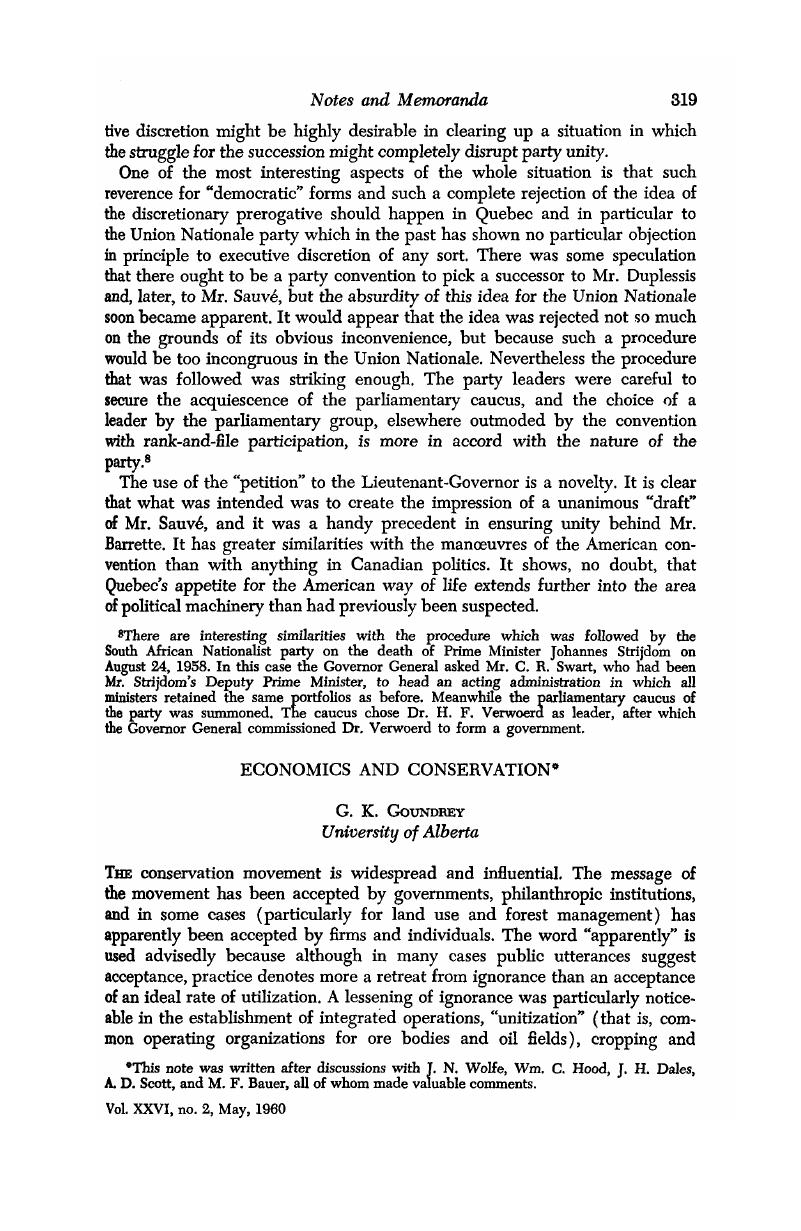Published online by Cambridge University Press: 07 November 2014

This note was written after discussions with J. N. Wolfe, Wm. C. Hood, J. H. Dales, A. D. Scott, and M. F. Bauer, all of whom made valuable comments.
1 Boulding, K. E., “Income or Welfare,” Review of Economic Studies, XVII, 1949–1950, 85.Google Scholar
2 Robertson, D. H., The Control of Industry (Cambridge, 1923), 103.Google Scholar
3 Scott, A. D., Natural Resources: The Economics of Conservation (Toronto, 1955).Google Scholar
4 Williams, J. H., “An Economist's Confessions,” American Economic Review, XLII, no. 1, 03, 1952, 12.Google Scholar
5 This argument may require clarification. Much conservation literature has been directed at demonstrating: (a) that individuals and firms were not acting rationally (in economic terms), i.e. that people could have higher incomes or firms better profits if they changed their practices; examples are wind breaks, shelter belts, contour plowing, improved forest management and integrated operations; (b) that social benefits and private benefits differ; examples are watershed protection, flood and run-off control, and the close interrelation of resource utilization, tourism, and wildlife. In other words, in spite of an economic model with assumptions of rational behaviour and perfect knowledge, many of the conservation teachings were directed at making these assumptions realistic, through education.
6 The Economics of Stationary States (London, 1935).Google Scholar It should be added that the analysis is in real terms, i.e. constant income means constant consumption.
7 “In a stationary state both the stock of equipment and the annual rate of consumption must be constant. This implies that the rate at which equipment wears out and has to be replaced is constant. For, if this condition is not satisfied, the stock of equipment can only be held stationary by varying the amounts of income being withdrawn from consumption to meet depreciation in different years.” Ibid., 17.
8 Ibid., 21 (my italics).
9 Ibid., 22 (my italics).
10 Many students of economic thought contrast the theory founded on Ricardo with the type of growth theory that would have continued the Adam Smith tradition. I found two articles by J. H. Williams very helpful: “An Economist's Confessions”; and “An Appraisal of Keynesian Economics,” American Economic Review, XXXVIII, no. 2, 05, 1948, 273–90.Google Scholar The suggestion that the model of the stationary state underlies conservation teachings helps to explain why so many regulation theorists embrace conservation teachings.
11 Cf. also Schumpeter's “circular flow” in the absence of innovation and under competitive conditions.
12 The clearest statement of the counter-argument is by F. H. Knight, who maintained that physical capital need not come into the model at all (“Issues in the Economics of Stationary States,” American Economic Review, XXVI, no. 3, Sept., 1936, 393–411).Google Scholar This is equivalent to an assumption that resources and capital are indistinguishable as sources of income and that the permanent maintenance of income is a sufficient condition. The argument does not impress me, although it offers a concept of long-run equilibrium under perfect competition that is much easier to use. The acceptance of the Knight position leads directly to the statement by Scott, (“National Wealth and Natural Wealth,” this Journal, XXII, no. 3, Aug., 1956, 374)Google Scholar: “As time proceeds, unless the depleted soil, mines, and inaccessible forests are improved by investment of savings, income will tend to fall. … In the absence of technical change it is necessary to keep total (natural plus produced) capital per head constant in order to keep incomes per head from falling. As natural wealth per head disappears, produced capital per head must increase.” Pigou (p. 26) discussed the derivative nature of real capital but concluded that for practical purposes, one should consider capital an original factor of production.
13 See, e.g., Gibson, J. Douglas, “The Changing Influence of the United States on the Canadian Economy,” this Journal, XXII, no. 4, Nov., 1956, 431 Google Scholar: “An illustration of the sort of fallacious thinking which militates against effective discussion is the not uncommon suggestion that the Americans are making off with our wasting resources as though their use of these products would leave less for us in future. Except possibly over a very long period of time–too long to be of any interest to ourselves or to our grandchildren–this is a very doubtful proposition. As a practical matter the reverse is more nearly true, since the bigger the production the larger the expenditures for discovery and development and the larger the proven and usable resources. This is not always true of individual areas, but for countries the size of Canada and the United States it is not far from the mark.” Gibson suggests, however (pp. 422–3), that a unique market is provided for Canada by depletion or the inability to expand discoveries at the required rate in the United States. The long run, for the United States, has not proved to be very long. In any event, there are peculiarities about reserves in mining which I hope to discuss in a subsequent note.
14 Cf. the quotation from Scott, n. 12.
15 For a discussion of obvious deviations of social and private costs and benefits see my “Comments on Conservation,” Canadian Banker, summer, 1959. Perhaps the most obvious examples are: (1) Watershed protection and erosion control versus grazing and forest exploitation. (2) The smoke nuisance. How much does it pay to spend on a fume elimination system at a smelter? Fumes kill trees, but eliminating fumes is expensive. To complicate matters, the trees have a “social” value in excess of their market value because of the relation of forest cover to tourism, wildlife, recreation, control of run-off, etc. (3) Water pollution. Water is a major method of disposing of industrial waste. The effluent is in many cases more regular than the rate of flow of the rivers carrying waste. This is a serious problem, e.g., downstream from Edmonton on the North Saskatchewan River. (4) Town planning.